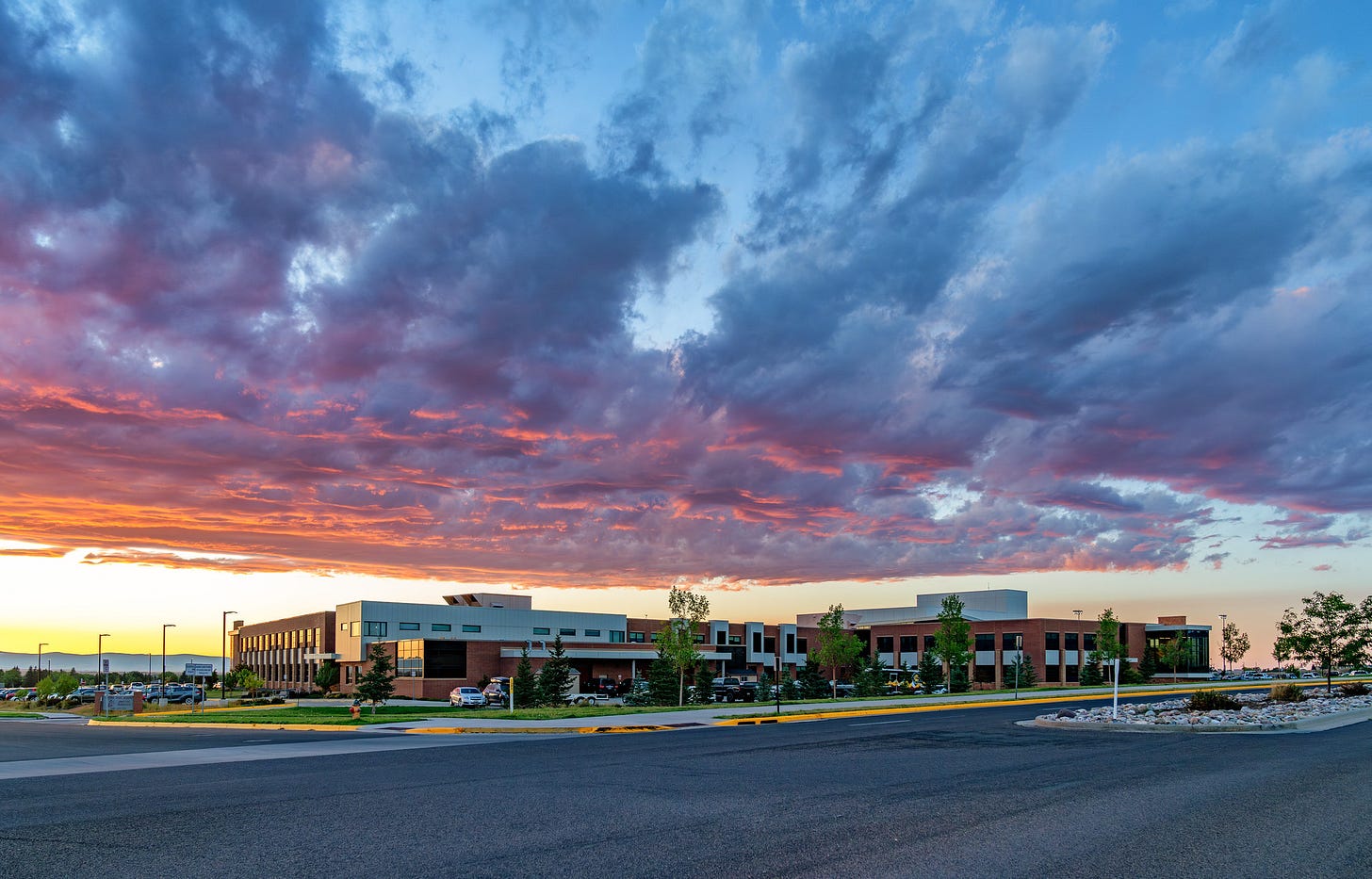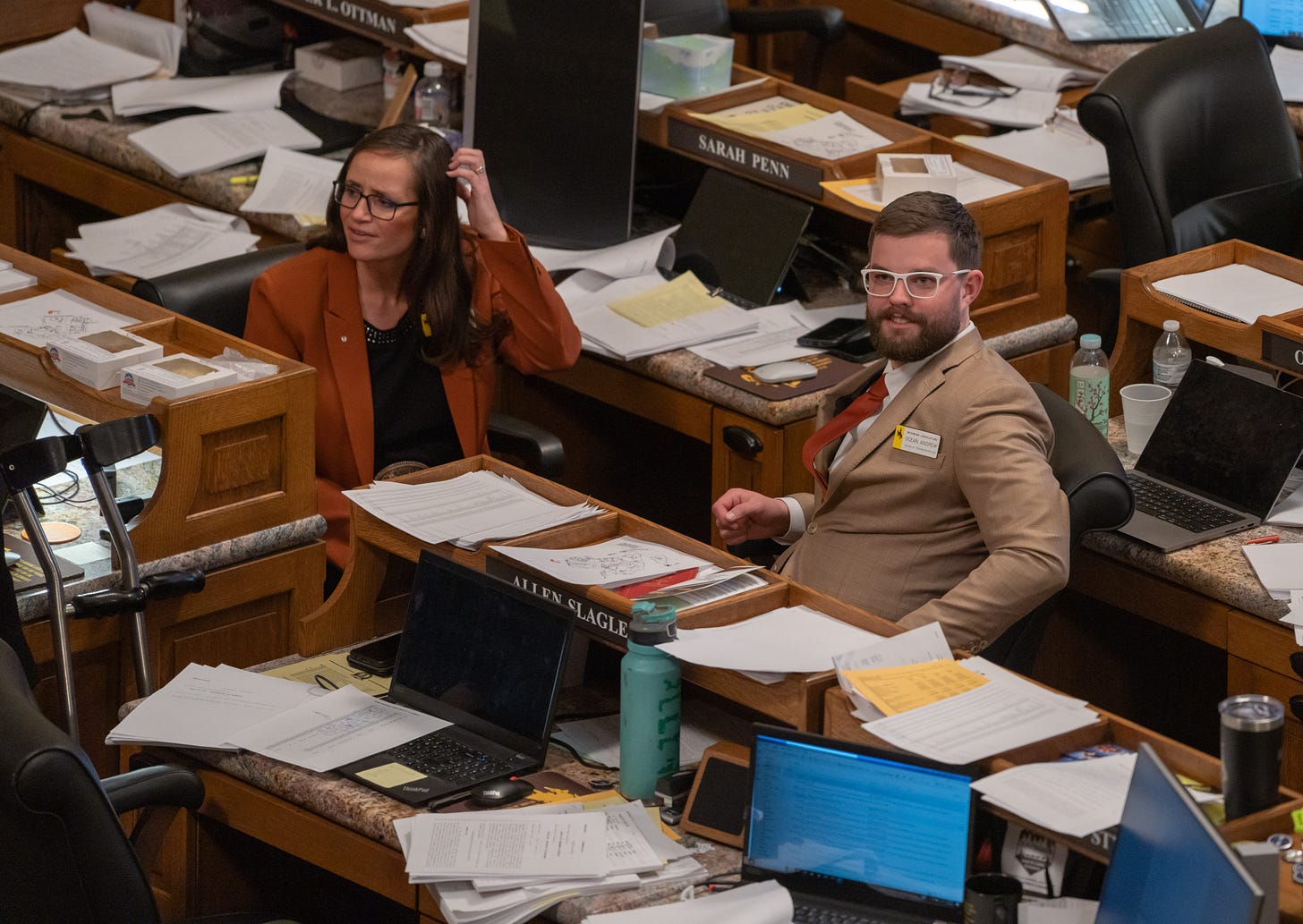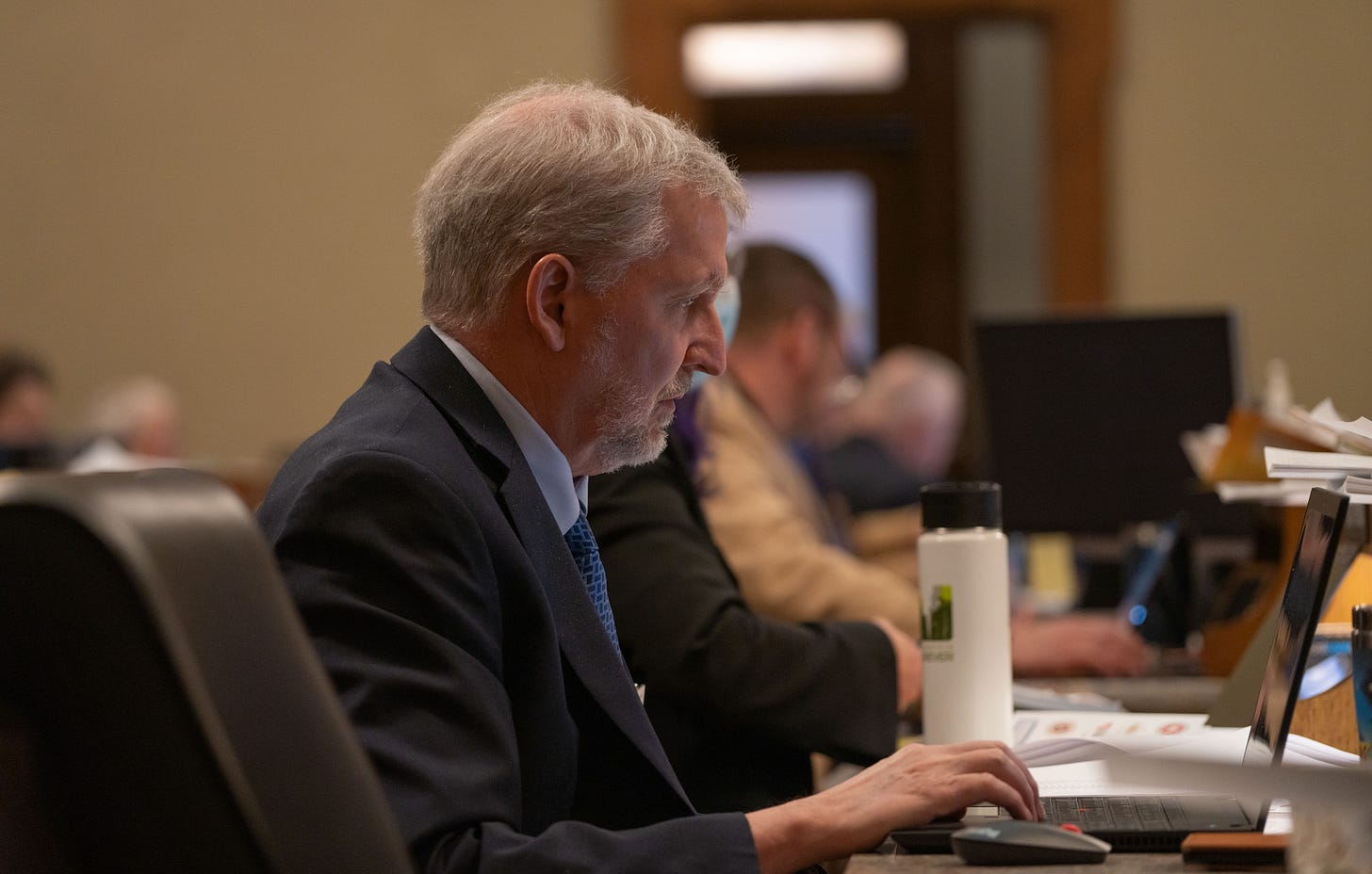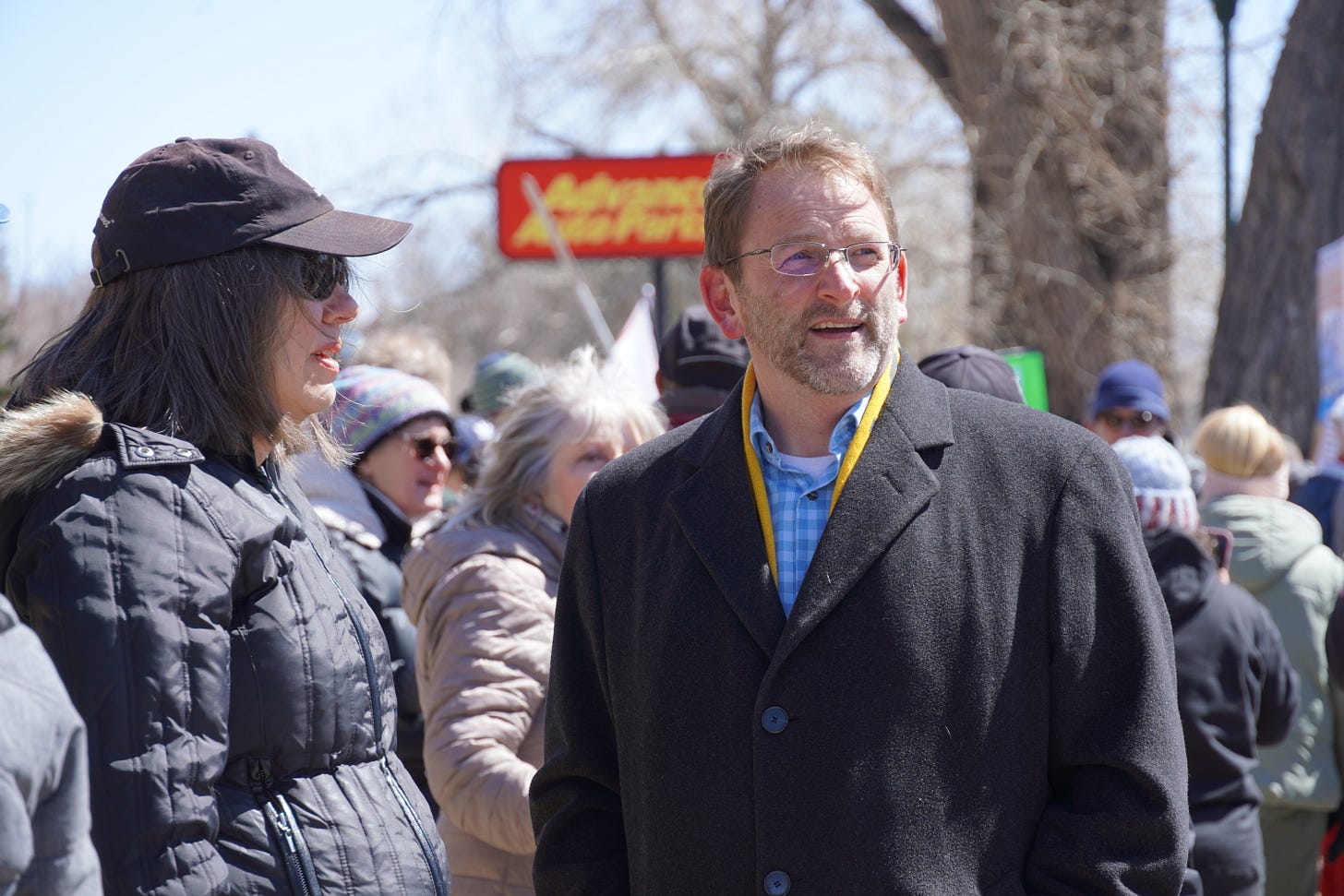4 Town Hall Takeaways
The Reporter moderated a bipartisan town hall Tuesday. It was attended by five of the county’s six lawmakers and about 90 members of the public.

Most of Albany County’s state delegation took part in a town hall moderated by the Laramie Reporter earlier this week.
It was the first, and so far only, bipartisan town hall of the 2025 interim season, providing the public access to legislators from both major parties.
The lawmakers discussed and debated a range of topics — from guns in schools to public lands to the purpose of government and taxation — while fielding questions from the public about these and other issues.
Roughly 90 people attended in person. The lawmakers agreed to go past their original 7:30 p.m. end time by about 20 minutes, allowing for more questions from the public.
The Talk Shop, a local radio program, streamed the event to its Facebook page, where a full recording remains available as of this story’s publication.
Below are four key takeaways from the Tuesday evening town hall, which saw lawmakers reflecting on the 2025 General Session and looking ahead to the 2026 Budget Session and beyond.
The rep from Albany County’s least competitive district was absent
Rep. Ocean Andrew (HD-46) was the only member of Albany County’s six-member delegation not to attend.
Andrew is unique among the delegation for his membership in Wyoming’s hardline Freedom Caucus, a right-wing faction of the state Republican Party that gained a majority in the House during the last election.
Its dominance in the lower chamber, and the dominance of its allies in the Senate, saw the ascendent faction rack up several victories, including the repeal of gun-free zones, the outlawing of university diversity, equity and inclusion programs and the passage of restrictive abortion legislation.

Andrew has seen his own influence expand with the elevation of his home faction.
He now serves as the Republicans’ fourth highest ranking House member as Majority Whip and helms the House Education Committee. As committee chair, he has shepherded a major expansion of Wyoming’s school voucher program, which he also sponsored, and helped to advance several anti-trans proposals now becoming law.
Andrew typically eschews bipartisan public appearances such as the local candidate forums hosted every election cycle by the League of Women Voters. His elections in deep-red House District 46 typically have not been considered competitive.
Andrew did not respond to multiple invitations to the Tuesday town hall.
Senators debated the end of gun-free zones
Sens. Gary Crum (SD-10) and Chris Rothfuss (SD-9) sparred over the repeal of gun-free zones.
During the most recent session, the Wyoming Legislature passed a bill allowing members of the public to carry concealed firearms into schools, into buildings at the University of Wyoming, and into other government facilities and gatherings — from school board meetings to legislative floor sessions.
Crum, unique among the lawmakers on stage, voted in favor of the repeal. He defended that decision.
“If you look at the statistics, they’re pretty black and white,” he said. “Where guns are held by responsible people in settings like this school — so a teacher goes out and gets a concealed carry permit where they’ve been trained — the data shows clearly that the school is much safer because the bad guys do not want to come in.”
The data is actually very complicated and it’s not clear that concealed carry laws deter would-be shooters. Advocates point to the lack of school shootings in places that allow concealed carry, but school shootings are rare everywhere, including also in places that don’t allow concealed carry.
Opponents, however, typically point to other concerns, such as what the proliferation of guns could mean in a state with very high rates of youth suicide and what it’s likely to mean for the prevalence of violent crime generally.

Crum argued further that guns are already present in most Wyoming schools and requiring concealed carry permits might stand to make them safer environments, not less.
“I really believe our kids are safer with concealed carry in the schools where people have been trained,” he said. “This bill was put in place where you have to have a concealed carry permit.”
Rothfuss said he disagreed with his “good friend, Senator Crum,” about the state of the data. But he focused his counterargument on another point: that the new law upended a functioning system and trampled local control.
Rothfuss, a long-time member of the Senate Education Committee, said he was there when that allegedly functioning system was established.
“[We] put forward a pretty thoughtful piece of legislation that I helped craft about seven years ago, which left it up to school districts,” he said. “If their community wanted it, and that local school board chose, they could have some teachers with concealed carry permits.”
That allowed Wapiti Elementary School, on the border to Yellowstone National Park, to protect itself from bears, while allowing Albany County Schools — where leadership is fiercely opposed to arming teachers — to keep school grounds in Laramie mostly gun-free.
The new law, by contrast, mandates every school district allow members of the public to carry on school grounds. Rothfuss said this “went too far” and eradicated local control.
The new legislation, Rothfuss added, is not limited to schools and colleges.
“It’s only in schools that you are required to have a permit,” he said. “So the folks up in the balcony of the legislature, for example, or the folks in your city council and county commission [meetings] just have to have constitutional carry. And all you need for constitutional carry in the state of Wyoming is a belief that you’re sane — that’s self-evaluated — and a desire to have a gun where you’re going.”
The property tax debate is really about something else
A discussion about property tax relief quickly transformed into a discussion about the role of government.
Even though Wyoming residents tend to pay far less in property taxes than other Americans, the topic has gotten a lot of attention from state lawmakers, who advanced several bills and set up a future ballot measure aimed at providing property tax relief to homeowners.
Notably, the state approved a 25% property tax cut for the first $1 million of a home’s value. And in 2026, voters could increase that cut to 50% by approving the ballot measure.
Cities, counties, education advocates and Democratic lawmakers have warned that such sharp cuts to the state’s revenue will result in sharp cuts to government services.
During the town hall, Rep. Trey Sherwood (HD-14) pointed to the cuts already impacting Albany County’s bottom line as well as the city of Laramie’s annual budget adjustments.
Laramie would have weathered an estimated $800,000-$1 million cut this year (attributable to the property tax cut) if not for rapid wind development in the area. Renewables funneled sales and use taxes into city coffers, resulting in a net $350,000 cut instead.

“Not every community is having a windfall because of industrial or economic development,” Sherwood said. “Niobrara County will probably be hit a lot harder. So there’s inequity across our cities and counties on how much this cut translates into services.”
But if Wyoming slashes property taxes in half, she said “the wind development isn’t going to save the city of Laramie in the years to come.”
Rep. Karlee Provenza (HD-45) acknowledged that many folks are struggling because their taxes went up with inflation, and she encouraged anyone in that boat to reach out to their local officials to get connected with existing relief programs.
But she also stressed that Wyomingites get a lot more from their government than they pay for.
“The average person in Wyoming gets $33,000 in government services that you don’t have to pay for,” she said.
Sen. Crum supported property tax relief and said cities and counties could “trim some fat” in response to falling revenue.
“I’m very sympathetic to the cities and counties,” the senator said. “They do a great job and provide services for us, but maybe, like me and my household, there is a way to trim some fat off the corners and still do a good job.”
One member of the audience challenged Crum on this comment.
“I’ve been hearing about trimming fat from government services my entire life,” the audience member said. “I see a city that is running extremely lean. I see, at the state level, understaffed state agencies all day. I’m curious, where do you see the fat I’ve been hearing about for decades?”
Crum said that was “a great question.”
“Where is it? I think that’s where the cities and counties can go look,” he said. “If there’s not 3% fat there, we’re going to find out pretty quick as citizens, right? We’re going to find out pretty quick that there’s not 3% there, and then we get a chance to vote in a year, little over a year now, on that. And we can vote not to cut property taxes because there was no fat. But if there is fat, the cities and counties are going to do a good job.”
This answer failed to assuage the audience member, who replied:
“Shouldn’t you have known what was going to get cut before you did it?”
Crum responded.
“Remember, the cut hasn’t taken place yet. There’s a chance for the cities and counties to work into it,” he said. “We can debate local control all we want. Each one of us can use the word ‘local control’ here … but I really do think this is a local issue. We'll see where it goes.”
Rep. Ken Chestek (HD-13) said he opposed further cuts to property taxes specifically because of the way they were handed to local governments.
“The legislature wanted to be the hero in cutting taxes,” he said. “We don’t have to solve the problem. We’re going to cut taxes. And you, counties and school districts and cities, you figure out what gets cut. You’re the bad guys for cutting the services. We’re the heroes for cutting the taxes. And I thought that was terribly unfair.”

Sen. Rothfuss added the cuts will disproportionately benefit those who are more well-off while disproportionately hurting those who have less.
“When we look at this 25% [cut] to the first $1 million [of a home’s value] that we passed — 20% of that value goes to Teton County,” he said. “20% of that cut is going to Teton County. And yet we’re all in it together, and we all end up suffering from that same cut.”
As Wyoming recalibrates its education funding model this year, Rothfuss said some will be looking to pay for the tax cut by mandating cuts to education.
“Well, why do we have to cut funding for education? Because we just cut the property taxes,” Rothfuss said. “And that’s the reality of it.”
Crum took issue with that analysis:
It’s real easy to say it’s an either-or. ‘We’re going to cut police.’ ‘We’re going to cut fire.’ ‘We’re going to cut your schools.’ That’s a talking point. There’s other things that can happen in the city. It doesn’t have to be schools. It doesn’t have to be fire. It doesn’t have to be police. It doesn’t mean your streets don’t get paved … And so when we hear these statements — ‘It’s either-or’ — that’s just not true. There’s something in the middle that makes it all work together.
But Rothfuss said there’s no way to cut revenue this much without touching education.
“We absolutely have to cut education at some point when we run out of funds. There’s no ‘or’ there,” he said. “When our revenue goes below our costs, there’s no alternative than to cut the costs, and that means cutting education.”
A hospital pricing transparency bill divided Dems
Not every issue is red vs. blue. Last session’s House Bill 121, for example, divided Albany County Democrats. The bill would have “required hospitals to list prices for medical items and services” among other provisions.
Sen. Rothfuss was a co-sponsor on the bill, and Rep. Sherwood voted in its favor. But her allies in the lower chamber, Reps. Chestek and Provenza, voted against it.
Rothfuss said the division between those on stage who voted for the bill and those who voted against it was overblown. He said he liked the proposal and ultimately endorsed it with his own vote on the Senate floor, but the senator admitted there were flaws with the legislation itself.
“As it worked its way through the process, some flaws came up, some concerns came up that are totally legitimate and valid concerns,” Rothfuss said. “And this is the legislative process. The legislature was not ready for that bill. The legislature killed that bill. My colleagues here voted against it. I think they’re great. I think it was a good choice.”

But Rothfuss’ fellow local Democrats have been catching flak for voting against a bill with a catch title promising price transparency.
“The fact that it’s trying to be weaponized right now, where you’ve got some extremist groups saying, ‘Wow, these members voted against hospital transparency’ is truly absurd,” Rothfuss said. “Sometimes we don’t pass bills — not because we don’t support the concept — but because the bills just aren’t ready.”
Chestek said he fundamentally believed in transparency.
“I’m in favor of transparency absolutely,” he said. “This bill didn’t do it. This bill made things worse.”
Chestek said the bill, as written, might have resulted in patients losing their bargaining power, which is why he voted against it. Provenza had an additional objection.
“I’m ideologically opposed to making patients have to shop,” she said. “If we want to reduce the cost of healthcare, then we should either cap what people pay [or], most importantly, we should expand Medicaid if we want to reduce the price of healthcare. 19,000 people right now could have healthcare. But we don’t do that. And the people running those ads fight that effort, so it’s a sham.”




I was the person at the town hall who asked about nonprofits. Senator Crum's answer was unsatisfactory, and he functionally used it to brag about raising money for the municipal bond for the high school. National, state, and local nonprofits are struggling right now, and in a state like Wyoming, nonprofits play a vital role in maintaining much of our social service infrastructure. The state cutting property taxes and the national government cutting direct grants and block grants to the state means funding is drying up for these organizations, which were government grantees. I hope they consider this when they continue to cut revenue, meaning even less government AND nonprofit assistance to the people who need it most.
Senator Crum's opening remarks makes him seem like a reasonable person working on very important issues from Water Rights, Infrastructure, Rural Hospitals, Public Education as well as the Judiciary. He seemed knowledgeable on the issues and empathetic in his approach to legislating. However, when he started explaining his rationale for the votes he made, it was clear he was willing to back junk science and ignore overwhelming, fact based pleas of the community when casting his votes.
From my vantage point, It is pretty easy to see how the GOP will take our Public Lands Federally and distribute them to the State for dispersal within the next 4 years. It will happen fast and the sales job has begun. Senator Crum seems reasonable when he says that we should be able to swap lands to make better use, he is clearly showing he has no idea that Public Lands can already be sold or swapped, when all parties agree and it makes sense. Karlee makes this point with the Pilot Hill example. Maybe Senator Crum believes the talking points he has been given on this issue, but he is a pawn in the taking of our lands.
The GOP in Wyoming from top to bottom is backing the taking and distributing of our Wyoming Public lands in the next 4 years. Just consider, in two short years, Harriett Hageman could be controlling the Wyoming SLIB in charge of dispersing these lands according to the "will of the people".
Our Federal Delegation has developed an "excellent plan" for dismantling our Land Management Agencies while selling the idea that it's a "better use". Of course it's a lie. Senator Crum believes that drivel and will promote this lie just like the one he made for the repeal of gun free zones. Black and White my ass.